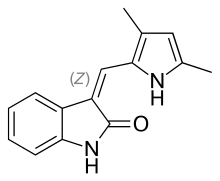Semaxanib
Semaxanib (INN,[1] codenamed SU5416) is a tyrosine-kinase inhibitor drug designed by SUGEN as a cancer therapeutic. It is an experimental stage drug, not licensed for use on human patients outside clinical trials. Semaxanib is a potent and selective synthetic inhibitor of the Flk-1/KDR vascular endothelial growth factor (VEGF) receptor tyrosine kinase. It targets the VEGF pathway, and both in vivo and in vitro studies have demonstrated antiangiogenic potential.
 | |
| Clinical data | |
|---|---|
| ATC code |
|
| Identifiers | |
| |
| CAS Number | |
| PubChem CID | |
| IUPHAR/BPS | |
| ChemSpider | |
| UNII | |
| ChEBI | |
| ChEMBL | |
| Chemical and physical data | |
| Formula | C15H14N2O |
| Molar mass | 238.290 g·mol−1 |
| 3D model (JSmol) | |
| |
| |
| | |
Research
In February 2002, Pharmacia, the then-parent of Sugen, prematurely ended phase III clinical trials of semaxinib in the treatment of advanced colorectal cancer due to discouraging results.[2] Other studies, at earlier phases, have since been conducted.[3][4] However, due to the prospect of next-generation tyrosine kinase inhibitors and the inefficacy of semaxanib in clinic trials, further development of the drug has been discontinued.[5] A related compound, SU11248 (sunitinib), was further developed by Sugen and subsequently by Pfizer, and received FDA approval for treatment of renal carcinoma in January 2006.[6]
When combined with chronic exposure to hypoxia, SU5416 induces severe pulmonary hypertension in mice and rats. This property has been exploited to develop a series of useful, though controversial, rodent models of pulmonary arterial hypertension, the first and best characterized being the Sugen/Hypoxia (SuHx) mouse model.[7][8]
References
- World Health Organization (2001). "International Nonproprietary Names for Pharmaceutical Substances (INN). Proposed INN: List 85". WHO Drug Information. 15 (2). "Full text" (PDF). Archived from the original (PDF) on 2007-03-16. (244 KiB)
- "Pharmacia Announces Closing of SU5416 (semaxanib) Clinical Trials" (Press release). February 8, 2002. Retrieved 2007-03-20.
- O'Donnell A, Padhani A, Hayes C, Kakkar AJ, Leach M, Trigo JM, Scurr M, Raynaud F, Phillips S, Aherne W, Hardcastle A, Workman P, Hannah A, Judson I (October 2005). "A Phase I study of the angiogenesis inhibitor SU5416 (semaxanib) in solid tumours, incorporating dynamic contrast MR pharmacodynamic end points". British Journal of Cancer. 93 (8): 876–83. doi:10.1038/sj.bjc.6602797. PMC 2361651. PMID 16222321.
- Lockhart AC, Cropp GF, Berlin JD, Donnelly E, Schumaker RD, Schaaf LJ, Hande KR, Fleischer AC, Hannah AL, Rothenberg ML (April 2006). "Phase I/pilot study of SU5416 (semaxinib) in combination with irinotecan/bolus 5-FU/LV (IFL) in patients with metastatic colorectal cancer". American Journal of Clinical Oncology. 29 (2): 109–15. doi:10.1097/01.coc.0000199882.53545.ac. PMID 16601426. S2CID 26566099.
- Hoff PM, Wolff RA, Bogaard K, Waldrum S, Abbruzzese JL (February 2006). "A Phase I study of escalating doses of the tyrosine kinase inhibitor semaxanib (SU5416) in combination with irinotecan in patients with advanced colorectal carcinoma". Japanese Journal of Clinical Oncology. 36 (2): 100–3. doi:10.1093/jjco/hyi229. PMID 16449240.
- "FDA approves new treatment for gastrointestinal and kidney cancer". U.S. Food and Drug Administration (FDA). 2006. Archived from the original on 3 February 2006.
- Vitali SH, Hansmann G, Rose C, Fernandez-Gonzalez A, Scheid A, Mitsialis SA, Kourembanas S (December 2014). "The Sugen 5416/hypoxia mouse model of pulmonary hypertension revisited: long-term follow-up". Pulm Circ. 4 (4): 619–29. doi:10.1086/678508. PMC 4278622. PMID 25610598.
- Voelkel NF, Bogaard HJ (2021). "Sugen, hypoxia and the lung circulation". Pulm Circ. 11 (4): 20458940211051188. doi:10.1177/20458940211051188. PMC 8493318. PMID 34631012.